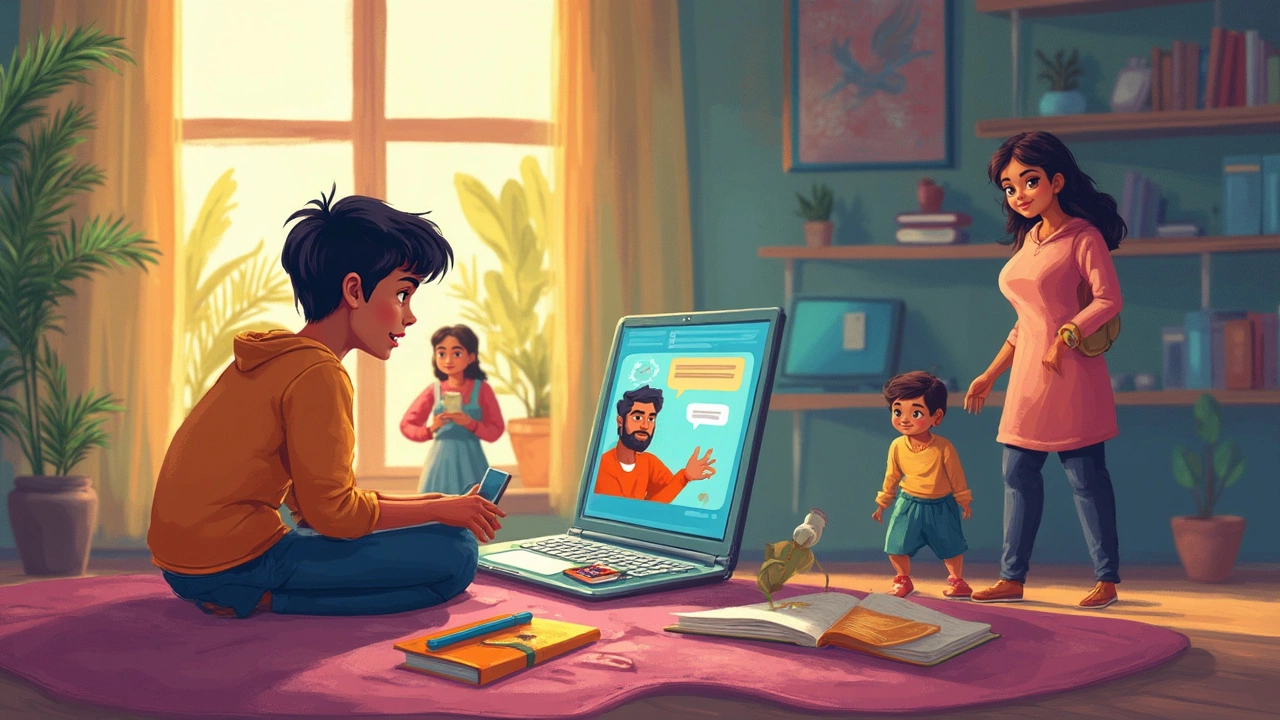
When most people hear “eLearning,” they picture watching boring videos or clicking through endless slides. But that’s not what today’s online learning platforms look like. Let’s get practical—with names you’ve actually heard, like Coursera. Millions of people have taken classes there in everything from digital marketing to family budgeting, all without ever stepping into a classroom.
Here’s the deal: eLearning means you can pick up skills straight from your laptop or even your phone. Instead of fighting traffic to sit in a dusty lecture hall, you log in, stream lessons, answer quizzes, and maybe even chat with classmates in forums. Everything’s built for your schedule.
Whether you’re a college student cramming before finals, a parent like me juggling work and kids (hi, Rhea!), or someone switching careers, these platforms let you decide when and how you learn. No dress code. No commutes.
- What Is eLearning, Really?
- Inside a Typical Course: The Coursera Example
- Tools and Features That Make a Difference
- Tips for Making eLearning Stick
- Why eLearning Works for Families and Busy Folks
What Is eLearning, Really?
eLearning isn’t just about watching videos or clicking through lessons online. It’s a game-changer for anyone who wants to pick up new skills, refresh their knowledge, or earn a certificate without being tied to a classroom. Basically, eLearning lets you learn at your own pace, on your time, using any device you like—laptop, tablet, or even a phone.
If you look at schools and companies around the world, they’re all tapping into eLearning. In 2024, the eLearning industry pulled in over $375 billion globally, which is wild compared to just $107 billion in 2015. That’s not just college students—everyone from office workers to retirees are jumping in.
So what sets a eLearning experience apart from old-school classes?
- Interactive content beats plain lectures—think quizzes, polls, and short videos.
- You get quick feedback. Forget waiting a week for a grade; you see how you did right after finishing an activity.
- Accessibility matters. If you’ve got an internet connection, you’re in.
- Many platforms offer certifications or badges with real value on your resume or LinkedIn.
Here’s a quick look at how much eLearning is growing:
| Year | Global eLearning Market Value |
|---|---|
| 2015 | $107 billion |
| 2020 | $250 billion |
| 2024 | $375 billion |
What’s all this mean? eLearning is flexible, mainstream, and only getting bigger. So, if you’re thinking of upgrading your skills or learning something new, there’s probably an online course out there with your name on it.
Inside a Typical Course: The Coursera Example
So what actually happens when you sign up for an online class on Coursera? Here’s the quick rundown: you pick a subject, enroll, and start right away or whenever you have time. Most courses are self-paced, meaning you can binge-learn or spread things out. No pressure from a classroom clock ticking down.
Your course dashboard is where everything happens. You’ll see upcoming lessons, assignments, and your grade progress. Lessons usually mix short video lectures (think 5–15 minutes each), bite-sized quizzes, and hands-on assignments. For example, I took a personal finance course for parents—each week had a few quick videos, a worksheet on budgeting, and a short quiz to check what stuck.
What’s cool is how interactive the platform feels. You can rewind or rewatch videos as often as you need. Got a question? Jump into the class discussion board—the instructors pop in with answers, and fellow students share tips. Some classes even add live Q&A sessions or group projects if you prefer a more social vibe.
- eLearning platforms like Coursera offer flexible scheduling, letting you start anytime and learn at your pace.
- Video quality is usually solid. Lectures are split into mini-chunks, so it never feels like a slog.
- Courses usually include a final project or test—you’ll actually use what you’ve learned, not just memorize facts.
- You can earn certificates, which might look shiny on your LinkedIn profile or even help at work.
Here’s some real data to give you the picture:
| Feature | Coursera Typical Course |
|---|---|
| Average Video Lectures per Week | 6–12 |
| Average Weekly Time Needed | 4–6 hours |
| Certificate on Finish | Yes (for paid courses) |
| Global User Base | Over 120 million |
| Languages Offered | Over 40 |
Don’t worry about being left in the dark—courses come with materials to download (like slides or checklists) and transcripts. If you get stuck midway, Coursera’s help center is decent, and lots of reviews from real learners make it clear which classes actually deliver value.

Tools and Features That Make a Difference
Online platforms like Coursera aren’t just about watching videos. What really sets them apart are the tools baked right in—ones that actually make learning stick. Here’s a closer look at what makes these platforms so useful for all sorts of people.
- Interactive Quizzes and Practice Exercises: After nearly every lesson, Coursera tosses in a quick quiz. It’s not just busywork—studies show that immediate feedback helps folks remember what they just learned. Getting a question wrong right after hearing the info is a fast way to learn and move on.
- Community Discussion Boards: Ever get stuck on a homework problem at 11 pm? Chances are, someone else is online and has your answer. On big platforms, these forums are super active, which helps you stay motivated and get unstuck without waiting for an email from the instructor.
- Downloadable Resources: Many courses include PDFs, slides, or even coding samples, so you’re not just stuck re-watching a video every time you need something. Handy for almost anything that needs reviewing on the go.
- Self-Paced and Flexible: Got five minutes at lunch? Or only time once the kids are in bed? No sweat. Lessons pause and pick up wherever you left them. Life doesn’t come with a syllabus, so this flexibility is gold, especially for parents and shift workers.
- Progress Trackers: Knowing how far you’ve come (or how far you’ve got left) makes pushing through a big course way easier. Visual trackers, like bars or percentage graphics, keep you honest and moving forward.
Many of these platforms also lean into mobile apps. I remember squeezing in micro-lessons while waiting for Rhea at dance class; more than 60% of Coursera’s users have joined via mobile at least once. Video transcripts and auto-captioning help for those who learn by reading instead of listening, plus it’s a win for anyone with hearing issues.
Here’s a look at how these features stack up with some stats from Coursera and similar platforms last year:
| Feature | % of Students Using Feature Weekly |
|---|---|
| Quizzes/Exercises | 78% |
| Discussion Boards | 54% |
| Mobile App Access | 62% |
| Downloadable Resources | 47% |
| Progress Tracking | 88% |
All these practical features really show how much eLearning platforms have evolved—not just to teach, but to make learning something you can actually use, anytime you want.
Tips for Making eLearning Stick
It’s one thing to sign up for an eLearning course, but it’s a whole other game to finish it—and actually remember what you learned. Most people drop out if they don’t find a rhythm that works for them. Figuring out a system early makes everything easier, whether you’re cramming for a career change or just want to pick up a hobby.
Here’s what research and real people say can help you actually finish and remember those online lessons:
- Set a routine: Mark your calendar for dedicated study times, even if it’s just 20 minutes a day. People who create a schedule are 50% more likely to finish their courses, according to a 2023 survey by Class Central.
- Mix up your learning: Don’t just watch the videos—use discussion boards, take notes, try quizzes, and do the exercises. Interacting with the material in different ways helps your brain lock in the info.
- Break it down: Huge modules are overwhelming. Take one topic at a time, and give yourself a mini-reward (coffee break, short walk, whatever works) when you finish each chunk.
- Get social support: Tell a family member or friend about your course—even better, ask them to check in on you or join you in learning. People who join course forums or WhatsApp groups tend to stick around longer because it feels less lonely.
- Set small goals: Instead of saying “I’ll finish the whole course this month,” aim for goals like “Complete two lessons this week.” Progress is way more motivating this way, and you’ll notice steady wins.
- Review, don’t cram: Instead of binge-watching 10 videos at once, revisit lessons later and quiz yourself. Spaced repetition boosts memory; it’s why language apps like Duolingo use daily reminders instead of marathon sessions.
Take a look at this table to see what keeps people on track versus what sets them back:
| Habit | Completion Rate |
|---|---|
| Regular, scheduled study sessions | 55% |
| Occasional, whenever-I-remember learning | 22% |
| Joining discussion groups or forums | 47% |
| No social interaction | 18% |
Everyone’s different, but most people stick with eLearning if they mix up activities, have accountability, and stay realistic about what they can handle each week. Find a system that fits your life, not the other way around.

Why eLearning Works for Families and Busy Folks
Life doesn’t slow down because you want to learn something new. If you’ve got kids, a job, or just not enough hours in the day, eLearning can fit into the gaps where traditional education can’t. Here’s why millions pick online courses over those old-school classrooms.
First off, flexibility is huge. My daughter Rhea’s after-school dance lessons? No problem. With eLearning, I can fit study time in after dinner or on a weekend morning. Most platforms offer self-paced courses, meaning you hit “pause” whenever you need, then jump right back in whenever you have time. No guilt trips from missing a lecture or turning up late.
For families, eLearning turns juggling schedules into a science. Say you’re prepping for a certification that might boost your paycheck or help you switch fields. You can swap lessons with school runs, nap times, and even grocery trips. The convenience is hard to beat, especially when you compare it to the rigid semesters of community college.
Here are some highlights of why eLearning hits different for busy folks and families:
- Most platforms, like Coursera, offer mobile apps. You can watch lectures on your phone while making dinner or waiting in the carpool line.
- Short, bite-sized lessons mean you don’t need huge blocks of time.
- Progress tracking helps you remember where you left off.
- Many courses offer downloadable materials, so no WiFi? No problem.
- Affordable pricing compared to in-person classes. Plus, plenty of free classes to try out.
The numbers back this up. A 2023 Coursera study showed that 64% of people enrolled in online courses had full-time jobs, and 45% had children at home. That’s a lot of multitasking!
| Group | % Of Online Learners (2023, Coursera Data) |
|---|---|
| Full-time workers | 64% |
| Parents with kids at home | 45% |
If you’ve ever thought you’re too busy, trust me, you’re the exact person eLearning was made for. With the right platform, you can upskill or even launch a whole new career without taking time away from what matters at home.
More Articles

Can You Really Learn Coding Without Strong Math Skills? Myths, Truths & Tips for Beginners
Think you must be great at math to learn coding? Not true. Discover how people without strong math backgrounds master coding and what really matters.

Which Is the Toughest MBA?
If you're eyeing an MBA, you've probably wondered which program would push your limits the most. Different MBAs provide varied challenges, from grueling finance courses to leadership hurdles. Understanding these intricacies can help you decide which program aligns with your career goals and personal resilience. Let's uncover the paths that demand the most grit.

